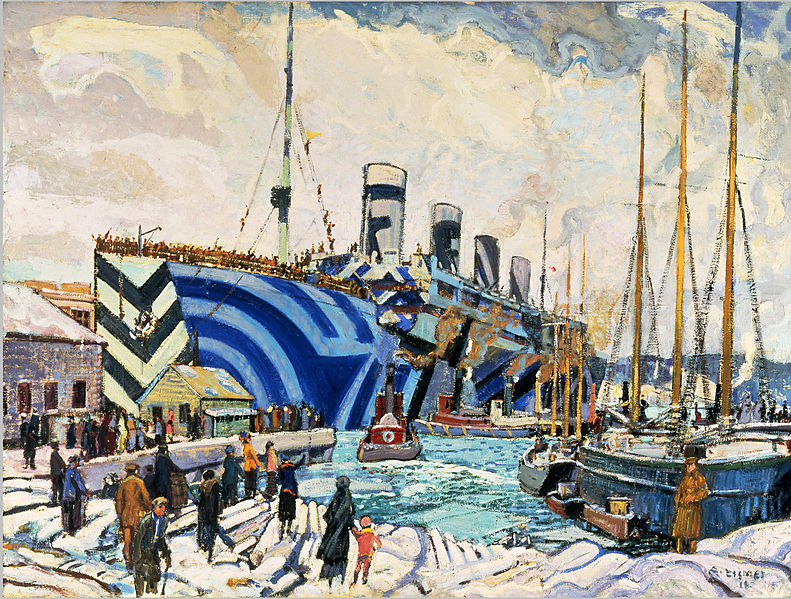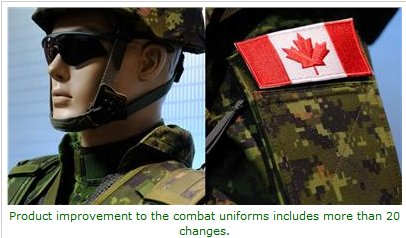Published on 11 Mar 2017
March 12, 2017
Camouflage Patterns – Funerary Practices – Prisoner Exchange I OUT OF THE TRENCHES
May 29, 2016
Dazzle Camouflage – Sabotage Operations I OUT OF THE TRENCHES
Published on 28 May 2016
Chair of Wisdom Time! This week we talk about Dazzle Camouflage and Sabotage Operations.
June 19, 2015
Camouflage – the changing of the spots
At Strategy Page, a quick look at the US Army’s latest change in camouflage clothing and equipment:
The U.S. Army has begun issuing its new combat uniforms featuring a new and improved camouflage pattern. This is yet another effort to deal with troop complaints about the shortcomings of earlier camouflage patterns. Back in 2012 the army has decided to scrap its current digital pattern camouflage combat uniforms and replace them with the more effective (according to the troops), but more expensive, MultiCam. Actually, MultiCam itself was not used but a pattern selected for the new uniforms, but one based on MultiCam. This variant is called Scorpion W2 and the army gave it another, official, name; Operational Camouflage Pattern (OCP). So if you hear someone talking about the new uniform being Scorpion W2 or MultiCam they are not entirely wrong. But the final, official term is OCP.
Since 2001 both the army and marines adopted new, digital camouflage pattern field uniforms. But in Afghanistan U.S. soldiers noted that the marine digital uniforms (called MARPAT, for Marine Pattern) were superior to the army UCP (Universal Camouflage Pattern). Both UCP and MARPAT were introduced at the same time (2002). From the beginning there was growing dissatisfaction with UCP, and it became a major issue because all the infantry have access to the Internet, where the constant clamor for something better than UCP eventually forced the army to do something.
This is ironic because UCP itself was another variant of MARPAT but a poor one, at least according to soldiers in UCP who encountered marines wearing MARPAT. Even more ironic is that MARPAT is based on research originally done by the army. Thus some of the resistance to copying MARPAT is admitting the marines took the same research on digital camouflage and produced a superior pattern for combat uniforms.
May 14, 2015
A new application for “dazzle” camouflage
Military History Now looks at some of the more eye-catching camouflage schemes of the world wars and suggests that something like it may have a modern application:
… nearly a century after the advent of dazzle, Dr. Nick Scott-Samuel of the University of Bristol believes that similar camouflage patterns painted on the sides of today’s jeeps and armoured cars will make it harder for enemy combatants to get a fix on military vehicles.
“Scott-Samuel, is the first to find evidence that dazzle camouflage can affect perception of speed – but only if the camouflaged object is moving quickly,” says a spokesperson with the British school. “These findings suggest that, while it would probably not have successfully distorted ships’ speeds in the two World Wars, dazzle camouflage could play a role in today’s battlefields where fast-moving army vehicles frequently come under attack from shoulder-launched, rocket-propelled grenades.”
Scott-Samuel arrived at his conclusion after putting volunteers through a series of visual tests. Researchers asked subjects to estimate the distance and speed of camouflaged objects in computer-simulated environments.
Participants observing virtual objects with dazzle patterns believed the targets were moving as much as 7 percent slower than they really were. Those who viewed unmarked objects were more likely to correctly estimate their speeds.
Scott-Samuel says the results indicate that military vehicles bearing dazzle patterns would be harder to hit than those painted with ordinary drab colours.
May 28, 2013
Charles Joseph Minard died for our (infographic) sins
Do you remember seeing the amazingly informative diagram by Charles Joseph Minard on the statistical side of Napoleon’s disastrous march on Moscow:
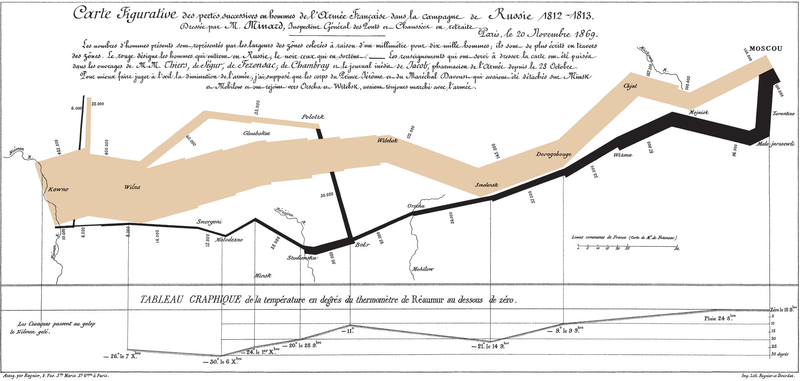
Charles Joseph Minard’s famous graph showing the decreasing size of the Grande Armée as it marches to Moscow (brown line, from left to right) and back (black line, from right to left) with the size of the army equal to the width of the line. Temperature is plotted on the lower graph for the return journey (Multiply Réaumur temperatures by 1¼ to get Celsius, e.g. −30 °R = −37.5 °C)
That is what a really good infographic can be. But, as Tim Harford points out, they’re not all that good:
Camouflage usually means blending in. That wasn’t an option for the submarine-dodging battleships of a century ago, which advertised their presence against an ever-changing sea and sky with bow waves and smokestacks. And so dazzle camouflage was born, an abstract riot of squiggles and harlequin patterns. It wasn’t hard to spot a dazzle ship but the challenge for the periscope operator was quickly to judge a ship’s speed and direction before firing a torpedo on a ponderous intercept. Dazzle camouflage was intended to provoke misjudgments, and there is some evidence that it worked.
Now let’s talk about data visualisation, the latest fashion in numerate journalism, albeit one that harks back to the likes of Florence Nightingale. She was not only the most famous nurse in history but the creator of a beautiful visualisation technique, the “Coxcomb diagram”, and the first woman to be elected as a member of the Royal Statistical Society.
Data visualisation creates powerful, elegant images from complex data. It’s like good prose: a pleasure to experience and a force for good in the right hands, but also seductive and potentially deceptive. Because we have less experience of data visualisation than of rhetoric, we are naive, and allow ourselves to be dazzled. Too much data visualisation is the statistical equivalent of dazzle camouflage: striking looks grab our attention but either fail to convey useful information or actively misdirect us.
[. . .]
Those beautiful Coxcomb diagrams are no exception. They show the causes of mortality in the Crimean war, and make a powerful case that better hygiene saved lives. But Hugh Small, a biographer of Nightingale, argues that she chose the Coxcomb diagram in order to make exactly this case. A simple bar chart would have been clearer: too clear for Nightingale’s purposes, because it suggested that winter was as much of a killer as poor hygiene was. Nightingale’s presentation of data was masterful. It was also designed not to inform but to persuade. When we look at modern data visualisations, we should remember that.
January 23, 2013
Canadian Army introduces updated combat uniforms
A press release describes the changes as the “most radical change since 1970s”:
After 18 months of testing and operational user feedback, production has begun on the Enhanced Combat Uniform for Canadian soldiers.
This product improvement to the combat uniforms includes more than 20 changes which will allow for greater comfort, enhanced protection and greater integration with personal protective equipment, allowing soldiers to more effectively train and perform their duties while deployed.
Some of the major changes are:
- a flexible Mandarin-style collar;
- integrated soft kneepads;
- flat pockets and zippers to avoid pressure points;
- an action-back for increased range of motion; and
- a flexible waist for improved fit.
“The uniforms are better integrated with the rest of the combat equipment while increasing comfort and providing greater wearing options adaptable to the environment a soldier is deployed in,” says Major Stéphane Dufour of the Director of Land Requirements’ Soldier Systems Requirements section. For example, the integrated soft knee pads provide protection in and outside a vehicle. The flat chest pocket style also removes any pressure points while wearing ballistic protection and fragmentation vests.
[. . .]
The uniforms will continue to use the Canadian Disruptive Pattern, known as CADPATTM, which allows soldiers to blend in with the field environment.
January 18, 2013
Camouflage patterns and the patterns of inter-service rivalry
In The Atlantic, D.B. Grady reminds us that some patterns are more deeply dyed than others:
Military combat uniforms have two purposes: to camouflage soldiers, and to hold together in rugged conditions. It stands to reason that there’s only one “best” pattern, and one best stitching and manufacture. It should follow that when such a uniform is developed, the entire military should transition to it.
In 2002, the Marine Corps adopted a digital camouflage pattern called MARPAT. Rigorous field-testing proved that it was more effective than the splotched woodland pattern in use at the time, and the Combat Utility Uniform (of which it was a part) was a striking change for such a conservative institution.
Not to be outdone, the Army drew up digital plans of its own, and in 2005 issued a redesigned combat uniform in a “universal camouflage pattern” (UCP). Three years after the Marines made the change, four years after the invasion of Afghanistan, and two years after the invasion of Iraq, you might think the Army would have been loaded with data on how best to camouflage soldiers in known combat zones. You would be wrong.
In fact, not only did the Army dismiss the requirements of the operating environments, but it also literally chose the poorest performing pattern of its field tests. The “universal” in UCP refers to jungle, desert, and urban environments. In designing a uniform for wear in every environment, it designed a uniform that was effective in none.
[. . .]
Such dysfunction is not unique to the Army. MARPAT was a success not only in function, but also in adding distinction to the Marines wearing it. Naturally the Air Force wanted in on that action, and set about to make its own mark on the camouflage world. It’s first choice? A Vietnam-era blue tiger-stripe pattern. (You know, to blend in with the trees on Pandora.)
After an outcry in the ranks, the leadership settled on a color scheme slightly more subdued. The new uniform did, however, have the benefit of being “winter weight” only, which was just perfect for service in Iraq.
November 9, 2012
Deception and counter-deception
Deception in war reached a crescendo in the latter stages of World War 2, with the allies’ use of General George S. Patton’s imaginary First US Army Group (FUSAG) to pin German attention on the Pas de Calais for more than a month after the real D-Day landings in Normandy. In addition to direct propaganda and an extensive radio network generating fake messages to show the size of FUSAG, the allies also created entire dummy airfields and flotillas of fake landing craft to show up on German air recon photos. The fake planes, aircraft, and buildings were a key part of maintaining the fictitious threat of another, bigger invasion — which successfully kept a large German force away from the real landings.
Less well-known is that the Germans also indulged in this kind of deception:
In what could easily be the finest and boldest example of death-defying and cheeky nose-thumbing during the Second World War or any conflict for that matter, bomber and intruder crews of the Royal Air Force and USAAF are reputed to have bombed the Luftwaffe’s decoy airfields and dummy aircraft, not with high explosives or incendiaries, but with nothing more than dummy bombs made of wood, and painted with the smug remark “Wood for Wood”… all just to make a point.
Throughout all theatres of war, during the Second World War, from China to Holland to Kent, air forces, phsy-ops units and logistics people constructed dummy targets such as airfields, factories, truck parks, convoys and even ships, out of wood, canvas, burlap, or inflatable rubber. The decoy airfields were often populated with dummy aircraft and vehicles of such high quality, that even low flying recce aircraft with photographic equipment would have hard time telling the difference between the dummies and the real thing. The decoy airfields and dummy aircraft served several purposes simultaneously. They confused snooping enemy aircraft and hence planners as to the number of aircraft available to the opposing forces as well as to their displacement. They provided decoy targets for enemy bombers which, if attacked would prevent real aircraft from being destroyed. Often, these airfields were built near real airports in the path of attacking aircraft in the hopes that they would then drop their bombs and strafe the dummies, thereby saving the real aircraft.
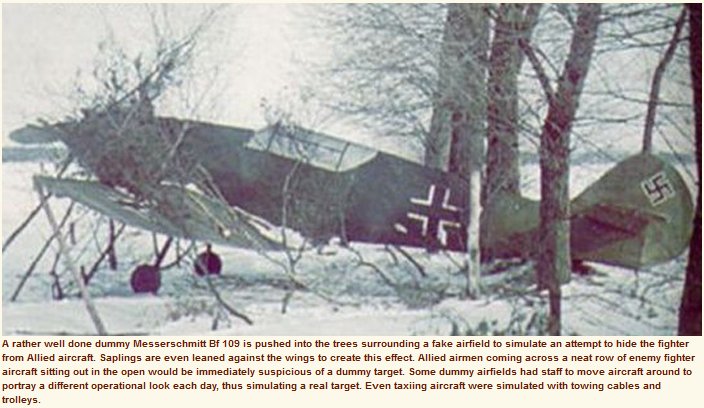
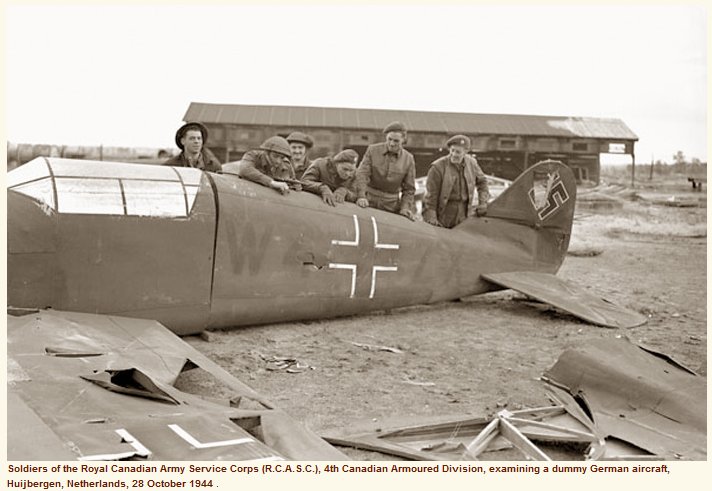
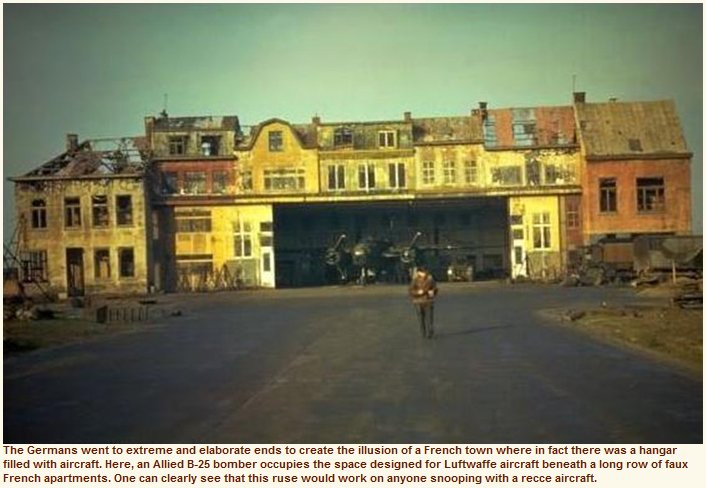
H/T to Roger Henry for the original link.
July 3, 2012
US Army’s UCP camouflage pattern “makes soldiers more visible, not less”
As I mentioned briefly last week, the US Army is abandoning their most recent camouflage patterned combat uniforms:
The United States military is abandoning its recently-adopted pixelated camouflage uniforms, according to articles this week in The Daily as well as Stars and Stripes.
The drab grey digital pattern, known as the Universal Camouflage Pattern (UCP), will be discarded after only eight years following mounting evidence that the colour scheme makes soldiers more visible, not less.
The articles pull few punches in their appraisal of the move to adopt the pattern in 2004.
“Army brass interfered in the selection process, choosing looks and politics over science,” reports Stars and Stripes, the official newspaper of the United States armed forces.
And while the Pentagon spent $5 Billion on the much-heralded uniforms, some of the earliest attempts to conceal soldiers on the battlefield were considerably less expensive.
The This is War blog has a discussion of the development of camouflage over the last century and a half.
June 29, 2012
US Army reluctantly admits USMC did better
In developing camouflage, that is:
The U.S. Army has decided to scrap its digital pattern camouflage combat uniforms for the more effective, but more expensive, MultiCam. In the last decade, both the army and marines adopted new, digital, camouflage pattern field uniforms. But in Afghanistan, U.S. soldiers noted that the marine digital uniforms (called MARPAT, for Marine Pattern) were superior to the army UCP (Universal Camouflage Pattern). There’s been growing dissatisfaction with UCP, and it has become a major issue because all the infantry have access to the Internet, where the constant clamor for something better than UCP forced the army to do something. This is ironic because UCP is a variant of MARPAT, but a poor one, at least according to soldiers who have encountered marines wearing MARPAT. Even more ironic is that MARPAT is based on research originally done by the army. Thus some of the resistance to copying MARPAT is admitting the marines took the same research on digital camouflage, and produced a superior pattern for combat uniforms.
A digital camouflage pattern uses “pixels” (little square or round spots of color, like you will find on your computer monitor if you look very closely), instead of just splotches of different colors. Naturally, this was called “digital camouflage.” This pattern proved considerably more effective at hiding troops than older methods. For example, in tests, it was found that soldiers wearing digital pattern uniforms were 50 percent more likely to escape detection by other troops, than if they were wearing standard green uniforms. What made the digital pattern work was the way the human brain processed information. The small “pixels” of color on the cloth makes the human brain see vegetation and terrain, not people. One could provide a more technical explanation, but the “brain processing” one pretty much says it all.
November 22, 2010
US Army suddenly discovers that women are shaped differently
It’s things like this that reinforce the impression that the military still hasn’t grown used to the fact that women are serving in combat zones:
Over the past seven years, the U.S. Army has responded to complaints from the troops about the combat uniform (ACU, or ACUPAT, for Army Combat Uniform camouflage pattern). But now the army is fixing a set of problems that have long been ignored; how the ACU fits women. Up to fifteen percent of the troops in combat zones are women, and the new uniform recognizes this. The older ACU just assumed female troops were one of the guys, which they are not. Women have a different shape, and that is very true when it comes to ACUs, and their placement of the waistline, many pockets and pouches for things like knee pads. What worked for the male body, did not work for female troops. Everything was just a little bit (or a lot) off, making the ACU much less comfortable for women doing the same jobs as the guys. So the army simply designed an ACU version based on the shape of the female body. The first prototypes were given to women to try out, and after a few hours, all the female troops asked where they could buy some more of them. Unfortunately, the female ACU won’t be available for another two years. Lots of additional tests have to be performed to make sure all the details are correctly incorporated.
Perhaps the physical variation among “average” women is relatively greater than that among “average” men, but it’s still surprising that the US Army is only now taking that into account.
September 17, 2010
Duelling camo patterns
A brief outline of the US Army’s quest to find better camouflage patterns for troops in the field:
While the MultiCam was an improvement on the older ACU pattern uniforms, the troops did not get new packs (which also use cano pattern cloth) at the same time they received the MultiCam uniforms. Thus when troops went off into the hills, the combination of MultiCam uniforms and ACU pattern packs do a lot to ruin the camouflage effect.
The U.S. military has been having a tough decade when it comes to camouflage uniforms. Since September 11, 2001, the U.S. Army has changed camouflage patterns for their combat uniforms twice. First it was the adoption of digital patterns, then the current move to MultiCam.
It was SOCOM (special operations command) troops who first had second thoughts about the older digital camo pattern. The digital camouflage pattern uses “pixels” (little square or round spots of color, like you will find on your computer monitor if you look very closely), instead of just splotches of different colors. Naturally, this was called “digital camouflage.” This pattern proved considerably more effective at hiding troops than older methods.
For example, in tests, it was found that soldiers wearing digital pattern uniforms were 50 percent more likely to escape detection by other troops, than if they were wearing standard green uniforms. What made the digital pattern work was the way the human brain processed information. The small “pixels” of color on the cloth makes the human brain see vegetation and terrain, not people. One could provide a more technical explanation, but the “brain processing” one pretty much says it all. Another advantage of the digital patterns is that they can also fool troops using night vision scopes. American troops are increasingly running up against opponents who have night optics, so wearing a camouflage pattern that looks like vegetation to someone with a night scope, is useful.

